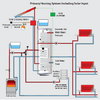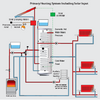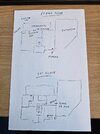Hey all,
We're planning to revamp our main bathroom and I'm keen to ensure we use this to boost the flow rate out of the shower for my wife and daughter, without us running out of hot water when my teenage daugher spends 30 minutes attempting to turn the bathroom into a sauna.
Basically I'm looking for a way to boost the flow rate from a new shower, whilst minimising disruption to the rest of the house.
Today we have a mixer shower fed from our combi boiler, and a second mixer shower in a new extension. We checked the combi spec as the extension was built and two separate plumbers advised that the combi should be more than powerful enough for both, but our main shower has moderate performance at best and when the new shower turns on, the flow in the main bathroom drops to a trickle (possibly because the new extension has 22mm pipework for the main runs, whereas in the old house nearly everything runs from 15mm).
I've also used a jug to measure the flow rates in the main bathroom and we're getting 12l/min from the cold tap, 5.2 from the hot tap, and 4.9 from the shower. I really want the shower to be able to achieve much better flow rates, ideally around 12l/min.
My own best guess (and I don't know how practical this is), is:
Unvented, direct 250-350l tank in the loft
This will give us 30 minutes of hot water for a good mixer shower.
We already have a high current feed in the loft as we had an electric shower before, and this effectively gives us an electrically heated shower if the combi ever fails.
It also means we should be able to run both showers at once, with decent flow to them both.
Warm water feed to cylinder
This is the bit I'm not sure is practical or even possible. We already have hot & cold feeds running to the loft for the shower, can we feed a cylinder from a 50/50 mix of cold water and hot water from the combi? The only output from the cylinder will be this shower, so could we connect hot water from the combi to the secondary return, and cold water to the base of the tank as normal?
Even with our current pipework, this should give us around 10l/min of warm water feeding into the cylinder, which should support a good flow rate to the shower and using the existing hot water pipes from the combi should mean even my teenage daughters can't ever run us completely out of hot water.
Long term - 22mm piping
In the much longer term, the next time we redecorate the bedroom we'll upgrade the main feed from the stop tap from 15mm to 22mm. That should help the whole house but also give us a much better flow into the tank, potentially boosting the main shower to 15l/min. Later on, as we redecorate the hallway we'll run that 22mm feed through to most of the house, improving the feed to the combi and kitchen also.
I'm not sure how practical this idea is, or whether there's a simpler option I'm not aware of. Would love any and all input.
Thanks all.
We're planning to revamp our main bathroom and I'm keen to ensure we use this to boost the flow rate out of the shower for my wife and daughter, without us running out of hot water when my teenage daugher spends 30 minutes attempting to turn the bathroom into a sauna.
Basically I'm looking for a way to boost the flow rate from a new shower, whilst minimising disruption to the rest of the house.
Today we have a mixer shower fed from our combi boiler, and a second mixer shower in a new extension. We checked the combi spec as the extension was built and two separate plumbers advised that the combi should be more than powerful enough for both, but our main shower has moderate performance at best and when the new shower turns on, the flow in the main bathroom drops to a trickle (possibly because the new extension has 22mm pipework for the main runs, whereas in the old house nearly everything runs from 15mm).
I've also used a jug to measure the flow rates in the main bathroom and we're getting 12l/min from the cold tap, 5.2 from the hot tap, and 4.9 from the shower. I really want the shower to be able to achieve much better flow rates, ideally around 12l/min.
My own best guess (and I don't know how practical this is), is:
Unvented, direct 250-350l tank in the loft
This will give us 30 minutes of hot water for a good mixer shower.
We already have a high current feed in the loft as we had an electric shower before, and this effectively gives us an electrically heated shower if the combi ever fails.
It also means we should be able to run both showers at once, with decent flow to them both.
Warm water feed to cylinder
This is the bit I'm not sure is practical or even possible. We already have hot & cold feeds running to the loft for the shower, can we feed a cylinder from a 50/50 mix of cold water and hot water from the combi? The only output from the cylinder will be this shower, so could we connect hot water from the combi to the secondary return, and cold water to the base of the tank as normal?
Even with our current pipework, this should give us around 10l/min of warm water feeding into the cylinder, which should support a good flow rate to the shower and using the existing hot water pipes from the combi should mean even my teenage daughters can't ever run us completely out of hot water.
Long term - 22mm piping
In the much longer term, the next time we redecorate the bedroom we'll upgrade the main feed from the stop tap from 15mm to 22mm. That should help the whole house but also give us a much better flow into the tank, potentially boosting the main shower to 15l/min. Later on, as we redecorate the hallway we'll run that 22mm feed through to most of the house, improving the feed to the combi and kitchen also.
I'm not sure how practical this idea is, or whether there's a simpler option I'm not aware of. Would love any and all input.
Thanks all.
Last edited:




